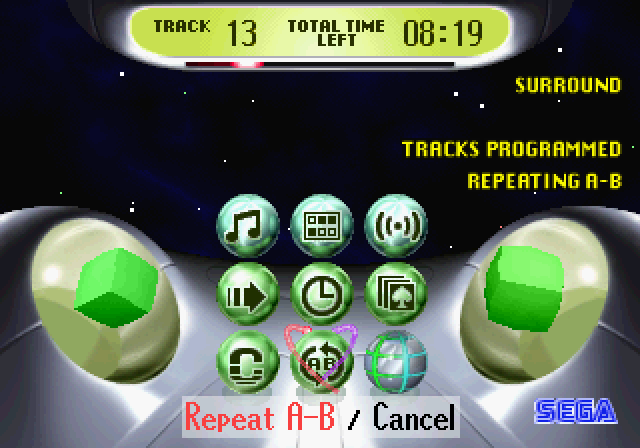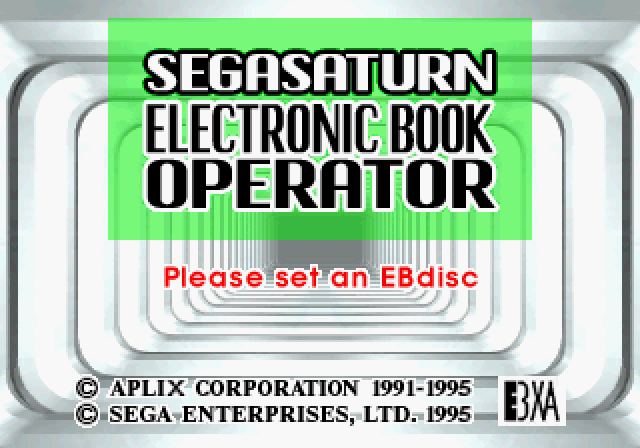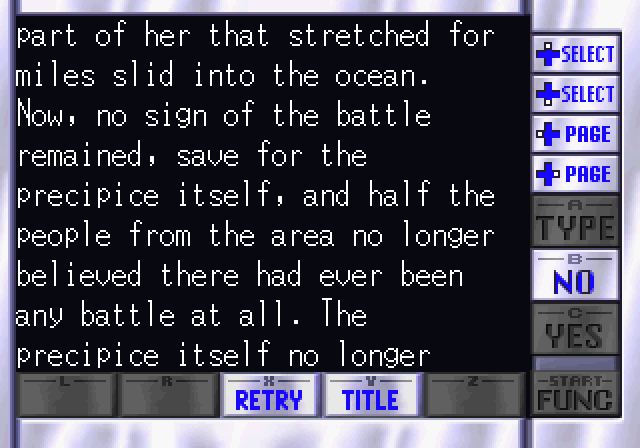It was never especially well highlighted outside of Eastern markets, but the humble Saturn was in fact built to handle various disc-based media over and above game and music CDs. Whether natively or with expansion ware, ‘multimedia’ was the ultimate potential of the Saturn platform. If a 1990s application was delivered on a compact disc, chances were fair that the Saturn could play it.
Disc (un)Suitable for this System
As with nearly every other contemporary console, the Saturn can play back CD-DA / compact disc – digital audio music CDs via the CD Player built in directly into the dashboard. Standard 12cm and 8cm mini-disc music CDs are supported — indeed, the half-rings inside a Saturn console’s CD well correspond to the outline of both 8 and 12 cm disc profiles. The many CD player functions available include “mute vocals” (suppression of central portion of soundtrack), simulated surround sound, pitch adjust, program sequence, shuffle, and others. Users can minimize controls and watch the Saturn screensaver while music plays; controllers have CD control functions pre-mapped so that functions can execute without bringing the dashboard controls back up.

The Saturn will play back any music CD tracks, including those found on Saturn and other format discs, provided that they comply with the 1982 red book CD-DA standard developed jointly by the good peoples at Phillips and those bastards at Sony.
CD+G (compact disc + graphics) is an extension of CD-DA that incorporates all the functionality of CD-DA and includes additional graphical data, stored in the typically unused six sub channels R through W. This special format has found niche acceptance with Karaoke, as CD+G discs are able to play back songs in high fidelity stereo and simultaneously display graphics (lyrics) on a screen. Graphics are limited to 16 colors (4-bit color depth) and a useable resolution of 288 by 192 pixels contained within a 12-pixel-wide border. This border is set to a single solid color, extending the on-screen resolution to 300 by 216. Therefore, graphics such as song lyrics that would animate — for example, change color as the song proceeded / as lyrics were sung, or as the lines of a song advance, would be contained within the 288 by 192 central area. The border could be masked by matching background color of the main screen.
CD+G graphics are rendered in tiles, and tiles can be sequentially drawn on screen in patterns. For instance, the final image can be rendered in with a checkered pattern, or a spiral, etc.
The CD+G format is not limited to karaoke lyrics — in effect, any graphics can be displayed, but the limited resolution and color range restricts the practical use to simple shapes with primitive graphics and animation.
Although the compact disc format is declining in popularity, CD+G discs continue to be produced to this day.
A special player designed to read the additional subchannels is required to properly play back a CD+G disc, otherwise the graphics data is ignored and only the music portion plays back. The Saturn is able to read these subchannels natively. When a CD+G disc is inserted into the Saturn, most of the system’s dashboard retreats away, leaving only the central cluster of control buttons and the upper HUD display pane. These can be further hidden with the usual Hide Controls command, leaving a clean screen for graphics. The CD player controls mapped to every Saturn controller continue to apply in this mode, so songs can be started / paused / stopped / skipped using the X, Y, and Z buttons.
CD+EG (compact disc + extended graphics) is a further extension of CD+G. All functions of CD+G are retained but two sets of graphics can now be overlaid, extending the number of colors possible to 256 (CD+G’s 16 colors x 16 due to the overlay = 256). Animations are now also more dynamic, and the entire ‘canvas’ can be drawn upon – no more border! The resolution and tile system is retained.
The Saturn can also play CD+EG natively, however, commercial applications of CD+EG are exceedingly rare — or perhaps never implemented at all. However, thanks to the work of Mr. Man, a CD+EG demonstration disc authored by JVC/Victor has been uploaded to archive.org. The CloneCD disc image retains the subchannel data required for CD+EG and burning this image to disc will produce a CD+EG that the Saturn can read. This demonstration disc is a mix of CD+G and CD+EG tracks. The CD+EG tracks show off an impressive color palette and a very clever use of animations, using the Dungeon Master Nexus game as one example. The Saturn dashboard functions exactly as it does with CD+G in that most of it retreats, leaving only the control buttons and upper display, which can be further dismissed to fully see the Extended Graphics visuals.
Disc Requires System Application
The somewhat more well-known formats the Saturn can play require additional hardware or software to enable, and are now all arguably obsolete. These include the obscure Electronic Book format, Kodak’s Photo CD format, and even Video CD (MPEG-1) — a disc-based VHS-quality format that preceded DVD. Additional software discs, called Operators, were released to enable the Saturn to handle the E-book format (Japan only) and picture CDs (Japan and Europe). Multiple hardware daughterboard cards were released to enable Video CD (Japan and Europe) by SEGA and by SEGA’s hardware partners JVC/Victor and Hitachi. None of these were officially released in North America.
Electronic books were authored in EB, EB-G, and EB-XA formats and often sold on mini-discs, and were read on specialized hardware, such as a Sony Data Discman. Primarily sold in Japan, they nevertheless saw limited release in North America in the early 1990s. Releases included dictionaries, encyclopedias, and so on. These E-Books are not compatible with modern EPUB format eBooks read on Kindle, Kobo and similar devices.

)



Photo CDs on the other hand were designed by Kodak as a way of digitizing photos shot on film, and displaying them on consumer televisions of the time. This format was most successful with professional photographers looking to digitise their film in high resolution. The rise of the JPEG standard, as well as the decrease in scanner / digitizing costs and increase in compression efficiency prevented PCD from achieving the mass market acceptance Kodak had hoped for.


In effect, neither E-Book nor PCD formats gained mass popularity and the fact that the Saturn can play these formats back is today a historical curiosity, as both formats are largely obsolete.
VCD, as a format, did far better than either E-Books or PhotoCD. The format was especially successful in the East, prompting SEGA to release a special Video CD Saturn model just for the Asian market, with a Movie Card pre-installed for out-of-the-box VCD playback capability. Hitachi Saturns, considered premium models of the Saturn platform, always shipped with a Hitachi MPEG card included. JVC/Victor released the largest variety of cards, with the later models being able to decode both PAL and NTSC discs, as well as the PCD format, eliminating the need for a separate Photo CD Operator disc.

It must be noted that the Movie Cards were region-locked. All but one model was released in Japan, meaning they will only play movies back in Japanese Saturns – though VCDs themselves aren’t region-coded in any way, so a western VCD release will play in a Japanese Saturn with a Japanese Movie Card. A European, PAL card was officially released, and it will play back VCDs in PAL Saturns. With no official card released in North America, it is not possible to play VCDs back on US Saturns without some kind of bypass or modification.
This region lock applies only to VCD movies. A small number of Japanese Saturn games took advantage of the MPEG cards and are not affected by the region lock. One such example is JVC’s excellent car combat game Vatlva – with an MPEG card inserted, the game’s introductory FMV sequence will play in full screen and will look noticeably cleaner than the standard version. Famously, a single Saturn release requires the MPEG card to play – GameArts’ Lunar: Silver Star Story Complete MPEG Edition. This special edition greatly increases FMV quality and brings it to full screen. As developers learnt better ways to encode their video sequences, the need for a dedicated Movie Card declined, as can be evidenced by Game Arts’ own Lunar 2, which renders FMV sequences in full screen without the need for the Movie Card.
Drive Empty
Arguably, the Saturn is the most multimedia-versatile 5th generation console and the last one to support many of these now-obsolete formats. Even so, much of this additional functionality was never highlighted as the formats themselves were not overly successful. These capabilities exist today as windows into the much less standardized world of 1990s electronics formats. The ability to read an E-Book, watch a VCD movie, view digitized pictures, and enjoy a CD with graphics will surely only appeal to a razor-thin slice of current Saturn fans, but the charm and geek factor of doing so remains sky high.





“Those bastards at $ony” lol 😆!
Very fascinating article Peter. I love the Saturn for its flexibility, and this showcases it beautifully!
LOL I was wondering if anyone would catch that little dig. Thanks for your comments Adam. They are always appreciated!